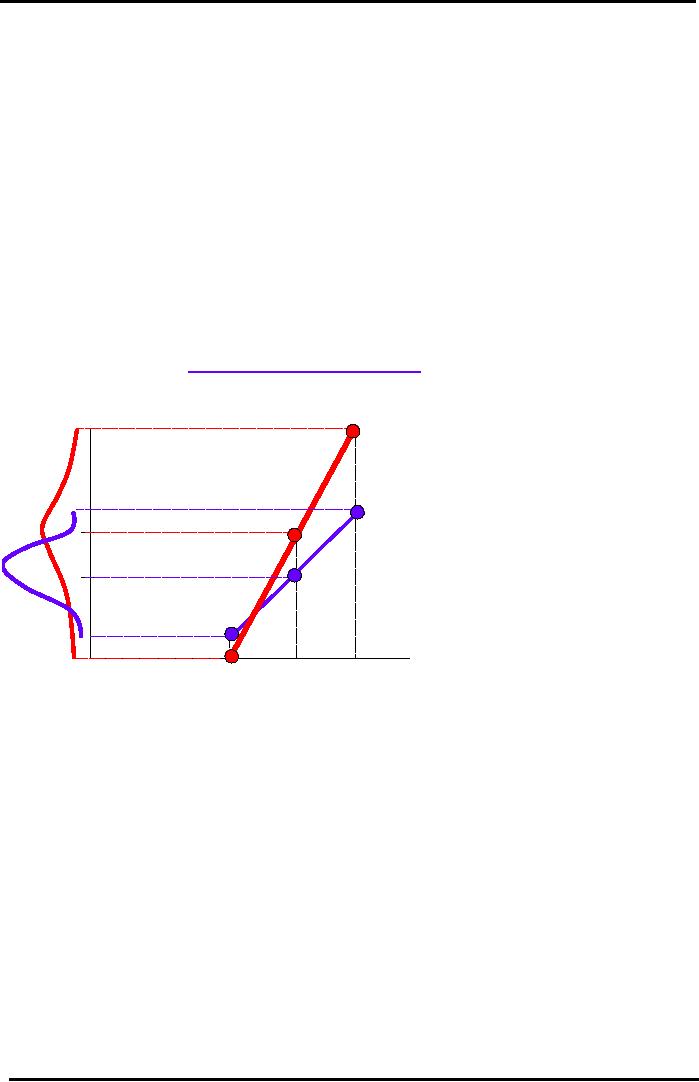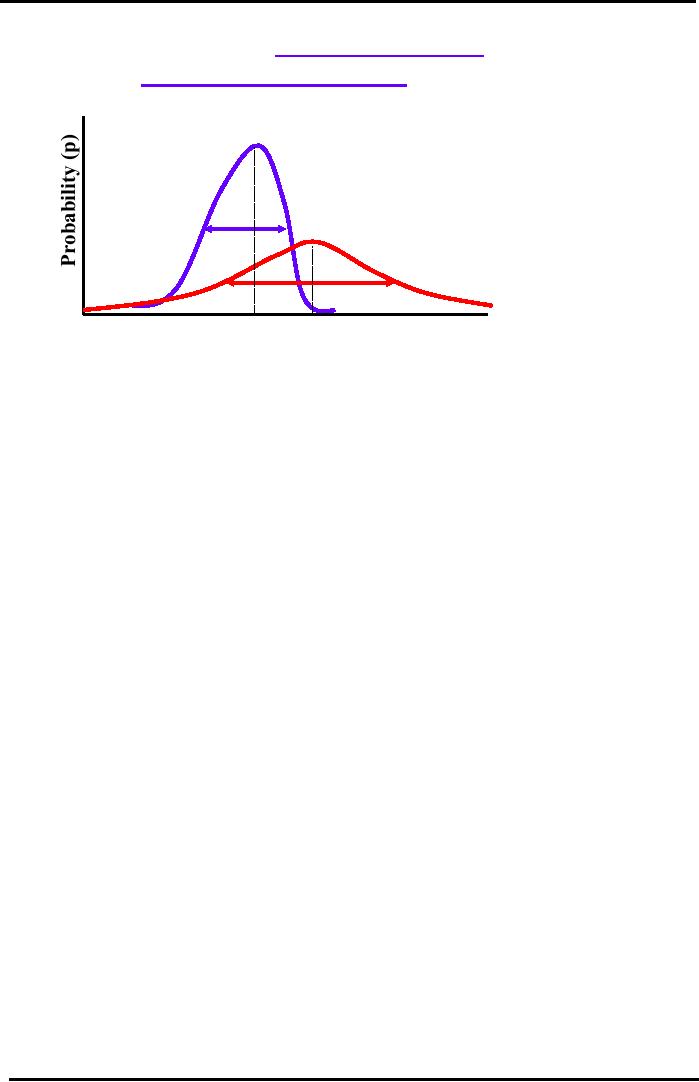 |

Financial
Management MGT201
VU
Lesson
32
FINANCIAL
LEVERAGE AND CAPITAL STRUCTURE
Learning
Objectives:
After
going through this lecture,
you would be able to have an
understanding of the following
topics:
�
Financial
Leverage
�
Capital
Structure
First
we recap some concepts of
previous lectures.
�
WACC
% = rD XD +
rE XE + rP XP.
(Debt, Common Equity, Preferred
Equity)
o
Where "r" is
ACTUAL COST which can be calculated
from REQUIRED ROR
after
accounting
for Taxes & Transaction
Costs.
o
Equity
Capital: If Not Enough Retained Earnings
then Equity Capital must be
financed
by
New Stock Issuance which is
more costly.
�
Total
Risk Faced by FIRM
=
Business Risk + Financial
Risk
�
Higher
Operating Leverage (OL =
Fixed Costs / Total
Costs)
o
Higher
Mean ROE WHEN FIRM'S SALES
> BREAKEVEN POINT
o
Higher
Fixed Costs means Higher
Breakeven Point and More
Chances of Operating
Loss.
Risk of Large Drop in Return
on Equity (ROE) so Higher
Risk.
Financial
Risk:
From
the discussion of the previous lecture we
can infer that
Financial
Risk = Total Standalone Risk
Business Risk
For
example, if
Total
risk as measured by standard
deviation of ROE of levered firm =
30%
and
Business risk as measured by
standard deviation of ROE of un-levered
firm = 20%
then
Financial
Risk = 30% - 20% =
10%
Financial
Risk is created when firms
take loan or debt. As
companies take more debt
they are exposed
to
more financial risk.
Financial
Leverage (FL):
Financial
Leverage shows the effect
that small increase in EBIT
can create much larger
increase in ROE
of
the firm.
Financial
Leverage (%) =Debt /Total
Assets = Debt / Debt +
Equity
If
firm has Rs.1000 of total
assets and Rs.500 debt then
it has 50% (=500/1000)
financial leverage. So
this
firm has 50% leverage
means 50% equity and
50% debt. Practically, firms
increase financial
leverage
by
Issuing New Debt (i.e.
Taking New Loans and
Increase Debt)
OR
Replacing Equity with
New Debt ( Increasing debt
and increasing equity
too)
Financial
Leverage Impact on Risk &
Return of Firm:
Financial
Leverage (or Debt Financing)
generally increases overall
risk & return of a firm.
Let
us
have a look now on a table
that shows how when a
firm becomes levered it
increases the variability
of
ROE and how it increases the
mean ROE.
Effect
of Leverage on ROE Volatility &
Risk
EBIT
Interest
EBT
Tax
Net
Income ROE
(Rs.50)
(30%)
(=NI/Equity)
Un-Levered
600
0
600
180
420
42%
Firm
with
300
0
300
90
210
21%
no
debt or 100%
50
0
50
15
35
3.5%
equity
Levered
firm
600
50
550
165
385
77%
with
debt
300
50
250
75
175
35%
50
50
0
0
0
0%
139

Financial
Management MGT201
VU
This
table shows the effect on ROE as earnings
change from Rs.50 to Rs.600.
This variation in
earnings
can be due to market forces or random
events. This variation in
sales revenue can lead
to
change
in EBIT and this is source of
risk. This will lead to
change in possible values of ROE. Results
of
the
table for levered and
un-levered firm indicate
that leverage (or Debt)
increases the spread or range
of
possible
ROE thereby increasing uncertainty and
risk. Financial Leverage (or
Debt Financing)
generally
increases
overall risk & return of a
firm due to the following
reasons:
�
Increases Return (Mean
ROE):
When EBIT /Total
Assets > Interest Cost
then Financial Leverage is
Good. Small Increase
in
EBIT can create much
larger Increase in ROE. If
EBIT
/Total Assets > Interest
Cost it means firm is
generating profit by the use of
its debt
resulting
in increased ROE as firm has
positive cash flows.
If Equity (and number of shares)
reduced then Return (NI) per
Share Increases. By
reducing
its
equity the firm will
increase its percentage of
debt in capital structure. As the
earnings
are
the same to be distributed among lesser
number of shares due to reduced equity
the
return
will increase per share
resulting in increased ROE.
These
two effects can be visualized in the
following graph:
Visualizing
Financial Leverage
(FL)
Impact
on ROE & Capital Structure
LEVERED
(Debt
ROE
(%)
&
Equity) Firm:
77%
Higher
Slope.
ROE
more
sensitive
to
changes
in EBIT
42%
35%
= <ROE>L
UN-LEVERED
(100%
Equity)
21%
= <ROE>UL
Firm.
Safer
Capital
Structure
3.5%
at
Low EBIT's
0%
EBIT
(Rs)
50
300
600
This
is the graphic representation of the above table of
Effect of Leverage on ROE Volatility
& Risk
for
a levered and un levered firm. It
indicates that leverage (or
Debt) increases the spread or range
of
possible
ROE thereby increasing uncertainty and
risk. Range of possible values of ROE have
been
indicated
by straight lines while
level of risk by the probability
distributions.
�
Increases Risk (Standard Deviation
in ROE):
Fixed Interest Dues so
Higher Chances of Losses, No
Dividends for Shareholders.
Possibility
of Large Drop in ROE. Possibly
Default. More Risk
Transferred to
Stockholders.
If Equity (and number of shares)
reduced then Risk per Share
Increases.
This
can also be visualized in the
following graph:
140

Financial
Management MGT201
VU
Visualizing
Impact of Financial
Leverage
on
ROE & Capital
Structure
Un-Levered
(100% Equity):
Lower
ROE and Lower Risk.
Levered
(Debt & Equity):
Risk
Higher
ROE but Higher
Risk
Risk
Mean
ROE
Mean
ROE
<ROE>Levered =
<ROE>Un-Levered
=
21%
35%
Return
on Equity ( ROE)%
Capital
Structure Theory:
From
the discussion of Financial leverage we
know Financial Leverage (FL
= Debt / (Debt +
Equity))
Increases
Overall Return (Mean ROE)
when EBIT/Total Assets >
Interest (or Cost of
Debt)
then
Leverage is Good because
small Increase in EBIT
causes much LARGER Increase
in ROE.
Increases
Overall RISK (Standard Deviation of
ROE) of FIRM. Leverage will
always
MAGNIFY
or AMPLIFY a small change in EBIT
into a LARGER change in
ROE.
�
Fundamental Principle in Risk-Return:
Rational Investors in Efficient
Markets will only take
Extra
Risk
if they are compensated by
Sufficient Extra
Return.
�
Should the Management of a Firm
undertake Financial Leverage? If so,
then how much
Debt
should
a Firm have?
Answer provided by Capital
Structure Theory.
Modigliani
- Miller:
�
Fathers of Corporate Finance
�
"Cost of Capital, Corporate Finance
and the Theory of Investment"
Revolutionary Article
Published
by Professors Modigliani & Miller in
American Economic Review in
June 1958.
Won
Nobel Prize.
�
"Pure
M-M" (or Modigliani-Miller) Model - IDEAL
CASE:
There
is no fixed ratio for debt
in capital structure. Generally it varies
with each company's
needs
and
requirements. Capital structure theory tries to
determine the most suitable
ratio for a firm.
Major Assumptions: No Taxes,
No Bankruptcy Costs, Efficient
Markets, Equal
Information
Available to All Investors
Major Conclusions:
�
Capital Structure has no affect on
value of a FIRM! Capital Structure
is
Irrelevant!
�
It does NOT matter how a
firm finances its operations, how
much debt it has
because
it has no bearing on a Firm's
Overall Value as calculated
using NPV!
�
Corporate Financing & Capital
Structure Decisions have no bearing on
Investment
(or Capital Budgeting)
Decisions.
�
Capital Budgeting can be
carried out without knowing
the exact Capital
Structure
of a Firm - you can assume
100% Equity (Un-levered)
Firm.
Keep
in view these conclusions of the theory
are correct only under the
ideal conditions as assumed
by
Modigliani-Miller.
141

Financial
Management MGT201
VU
Modified
MM -
With
Taxes:
In
order to apply it in the real
world for its use,
some other economists made
some modifications. In
order
to make this theory
applicable in the real world and to
account for the effects of corporate
and
personal
taxes on investment decision
and on firm, the effect of
taxes was included in
it.
�
Modigliani-Miller
(With Corporate
Tax)
In most countries, a Firm's
Interest Payments to Bond
Holders are NOT Taxed.
But
Dividend
Payments to Equity Holders
are taxed.
Based on CORPORATE TAXES,
FIRMS should prefer to raise
Capital using DEBT
Financing
rather than equity as there is saving
associated with capital
raised through
this
source.
From
firms point of view interest
payments are source of tax
savings.
�
Merton-Miller
(With Personal
Tax)
In most countries, INVESTORS
(bondholders and shareholders) pay a
higher Personal
Income
Tax on Interest Income from
Bonds than on Dividend Income
from Equity (or
Stocks).
Based on PERSONAL TAXES,
INVESTORS should prefer to
invest in STOCKS (or
Equity).
Uncertain
Conclusion:
Difficult to determine Net
Effect of taxes on optimal
capital structure. But,
practically
speaking, Corporate Tax Effect is
generally stronger so Based on Taxes
alone, Firms should
prefer
Debt.
We
shall discuss other
modifications in Modigliani Miller
capital structure theory along
with the one
discussed
above in the next lecture.
142
Table of Contents:
- INTRODUCTION TO FINANCIAL MANAGEMENT:Corporate Financing & Capital Structure,
- OBJECTIVES OF FINANCIAL MANAGEMENT, FINANCIAL ASSETS AND FINANCIAL MARKETS:Real Assets, Bond
- ANALYSIS OF FINANCIAL STATEMENTS:Basic Financial Statements, Profit & Loss account or Income Statement
- TIME VALUE OF MONEY:Discounting & Net Present Value (NPV), Interest Theory
- FINANCIAL FORECASTING AND FINANCIAL PLANNING:Planning Documents, Drawback of Percent of Sales Method
- PRESENT VALUE AND DISCOUNTING:Interest Rates for Discounting Calculations
- DISCOUNTING CASH FLOW ANALYSIS, ANNUITIES AND PERPETUITIES:Multiple Compounding
- CAPITAL BUDGETING AND CAPITAL BUDGETING TECHNIQUES:Techniques of capital budgeting, Pay back period
- NET PRESENT VALUE (NPV) AND INTERNAL RATE OF RETURN (IRR):RANKING TWO DIFFERENT INVESTMENTS
- PROJECT CASH FLOWS, PROJECT TIMING, COMPARING PROJECTS, AND MODIFIED INTERNAL RATE OF RETURN (MIRR)
- SOME SPECIAL AREAS OF CAPITAL BUDGETING:SOME SPECIAL AREAS OF CAPITAL BUDGETING, SOME SPECIAL AREAS OF CAPITAL BUDGETING
- CAPITAL RATIONING AND INTERPRETATION OF IRR AND NPV WITH LIMITED CAPITAL.:Types of Problems in Capital Rationing
- BONDS AND CLASSIFICATION OF BONDS:Textile Weaving Factory Case Study, Characteristics of bonds, Convertible Bonds
- BONDS’ VALUATION:Long Bond - Risk Theory, Bond Portfolio Theory, Interest Rate Tradeoff
- BONDS VALUATION AND YIELD ON BONDS:Present Value formula for the bond
- INTRODUCTION TO STOCKS AND STOCK VALUATION:Share Concept, Finite Investment
- COMMON STOCK PRICING AND DIVIDEND GROWTH MODELS:Preferred Stock, Perpetual Investment
- COMMON STOCKS – RATE OF RETURN AND EPS PRICING MODEL:Earnings per Share (EPS) Pricing Model
- INTRODUCTION TO RISK, RISK AND RETURN FOR A SINGLE STOCK INVESTMENT:Diversifiable Risk, Diversification
- RISK FOR A SINGLE STOCK INVESTMENT, PROBABILITY GRAPHS AND COEFFICIENT OF VARIATION
- 2- STOCK PORTFOLIO THEORY, RISK AND EXPECTED RETURN:Diversification, Definition of Terms
- PORTFOLIO RISK ANALYSIS AND EFFICIENT PORTFOLIO MAPS
- EFFICIENT PORTFOLIOS, MARKET RISK AND CAPITAL MARKET LINE (CML):Market Risk & Portfolio Theory
- STOCK BETA, PORTFOLIO BETA AND INTRODUCTION TO SECURITY MARKET LINE:MARKET, Calculating Portfolio Beta
- STOCK BETAS &RISK, SML& RETURN AND STOCK PRICES IN EFFICIENT MARKS:Interpretation of Result
- SML GRAPH AND CAPITAL ASSET PRICING MODEL:NPV Calculations & Capital Budgeting
- RISK AND PORTFOLIO THEORY, CAPM, CRITICISM OF CAPM AND APPLICATION OF RISK THEORY:Think Out of the Box
- INTRODUCTION TO DEBT, EFFICIENT MARKETS AND COST OF CAPITAL:Real Assets Markets, Debt vs. Equity
- WEIGHTED AVERAGE COST OF CAPITAL (WACC):Summary of Formulas
- BUSINESS RISK FACED BY FIRM, OPERATING LEVERAGE, BREAK EVEN POINT& RETURN ON EQUITY
- OPERATING LEVERAGE, FINANCIAL LEVERAGE, ROE, BREAK EVEN POINT AND BUSINESS RISK
- FINANCIAL LEVERAGE AND CAPITAL STRUCTURE:Capital Structure Theory
- MODIFICATIONS IN MILLAR MODIGLIANI CAPITAL STRUCTURE THEORY:Modified MM - With Bankruptcy Cost
- APPLICATION OF MILLER MODIGLIANI AND OTHER CAPITAL STRUCTURE THEORIES:Problem of the theory
- NET INCOME AND TAX SHIELD APPROACHES TO WACC:Traditionalists -Real Markets Example
- MANAGEMENT OF CAPITAL STRUCTURE:Practical Capital Structure Management
- DIVIDEND PAYOUT:Other Factors Affecting Dividend Policy, Residual Dividend Model
- APPLICATION OF RESIDUAL DIVIDEND MODEL:Dividend Payout Procedure, Dividend Schemes for Optimizing Share Price
- WORKING CAPITAL MANAGEMENT:Impact of working capital on Firm Value, Monthly Cash Budget
- CASH MANAGEMENT AND WORKING CAPITAL FINANCING:Inventory Management, Accounts Receivables Management:
- SHORT TERM FINANCING, LONG TERM FINANCING AND LEASE FINANCING:
- LEASE FINANCING AND TYPES OF LEASE FINANCING:Sale & Lease-Back, Lease Analyses & Calculations
- MERGERS AND ACQUISITIONS:Leveraged Buy-Outs (LBO’s), Mergers - Good or Bad?
- INTERNATIONAL FINANCE (MULTINATIONAL FINANCE):Major Issues Faced by Multinationals
- FINAL REVIEW OF ENTIRE COURSE ON FINANCIAL MANAGEMENT:Financial Statements and Ratios